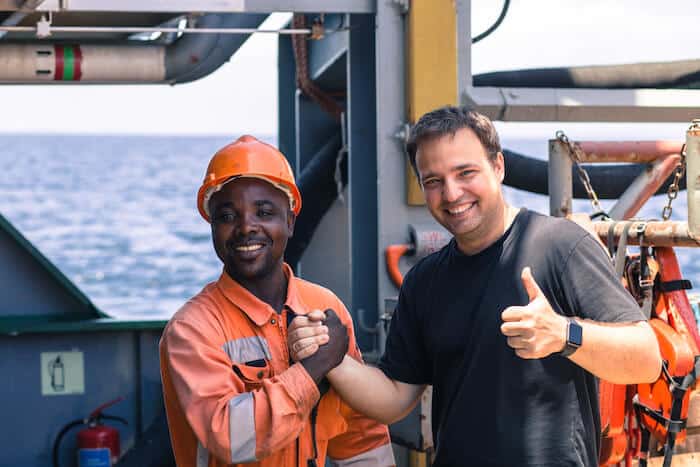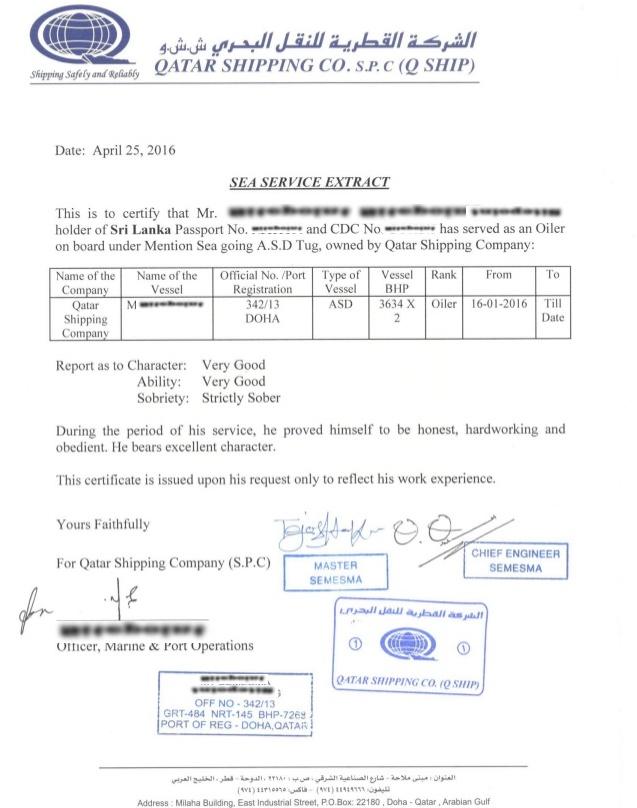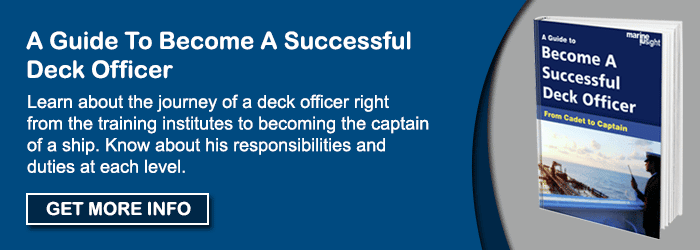What Is Sea Time?
What Is Sea Time?
Sea time is a term that holds a very important part in a seafarer’s professional life.
The word “Sea Time” does not mean the total time spent by a seafarer at sea, but it is the total time spent working on a vessel at sea, which is not standstill and is actively sailing for cargo transportation.
The sea time requirements for seafarers may differ from country to country, depending upon the minimum qualification requirements, which is drawn as per the STCW 2010 guidelines.
Sea Time is actually a document provided by the department head (chief engineer and ship captain) to the seafarer, endorsing that the seafarer has sailed on the ship for a particular period of time.
The details of the ship including name, IMO number, Tonnage, Engine particulars etc. are provided in the document.
The sea time certificate also carries remarks on behaviour and professionalism of the seafarer for the time spent on board.
The document needs to have the ship’s official stamp and master’s signature to prove the authentication.
It is important for the seafarer to collect and keep all the Sea time Certificates as it will be asked for by the company and the examination officer during the Certificate of Competency Exams.
It can be said that the Sea Time certificate is somewhat equivalent to a Service letter that people get on land for their jobs. However, the sea time letter needs to be acquired on each ship before signing off from it, or when the department head is signing off.
Hence, you can have 2-3 sea time certificates from one ship unlike one service letter when someone leaves a conventional ( land) job say after 5 years of service.
Why Is Sea Time Important?
The difference between merchant navy and other jobs is that the ship operations work under a chain of command which will stay the same even if the seafarer changes the shipping company or ships.
Also, as a seafarer you are always planning and working toward your next promotion and a person working on a ship can actually get themselves endorsed as an officer of higher rank by an authorized government body once they pass an exam held for a certificate of competency.
For qualifying for these exams, one needs to fulfil a minimum sea service requirement, whose duration will depend upon the rank you are in and the COC you are applying for.
For shipping companies, they have their own promotion criteria requiring candidates to fulfil provided sea time on a certain position, usually called the “Company’s Matrix System”.
Once the Sea Time is achieved and depending on one’s performance, the company will grant promotion either on the next ship or onboard the same ship, as per the agreement between the company and the seafarer.
If you are working for a single company for a long time, they have the record of the sea time in their official system.
However, if you decide to change your company these sea time certificates will come very handy to prove that you have enough work experience in a certain position.
There are many beginner and advanced courses which need to be done periodically by a seafarer as he/she progresses in the career.
To opt for these courses, you need to have a defined sea experience as per the sea time certificate so that you are eligible to apply for them.
For e.g., the basic STCW courses such as Basic fire fighting etc. need to be done before joining the ship. However, Advance fire fighting can be done when a candidate has a sea time, i.e. the person has been on a ship and has a little experience of onboard systems.
How Sea Time is Calculated?
As soon as the seafarer boards the ship and handover the document which includes COC (for officers) and seafarer identification document, the master will put on the stamp on it with a remark that the person has joined the ship in particular rank or capacity.
Hence, the sea time calculation will be started from the date of stamping. Different countries may have different sea time requirements and calculation processes. For e.g. in the United States, the sea time is calculated in days, which includes all the days the seafarer was onboard ship until the last contract, including the day not worked at all. i.e. till the sign-off.
For India and Australia watchkeeping certificates, the requirement is stated in “Number of Months”. Hence, the Sea Time certificate will carry the time spent on board either in a number of days or number of months, depending upon the nationality of the seafarer or the choice of COC he/she wanted to opt.
If the ship is in drydock or layoff and there are no voyages for a long period, it will still be considered as valid days and included in the sea certificate if the period of dry dock or lay off is less than 2 months. Hence, the Master should issue a sea time certificate for such candidates onboard.
Under Sea time document, a day of work is defined as eight hours of work doing assigned or watchkeeping duties and overtime is not included in that.
Many government states such as USCG and AMSA also specify that if the person is taking 12 hours job onboard a ship in a day, the sea time will be calculated as 1 day + one-half day of service credit.
The general practice on a ship is to specify the sea service time in months or years, and later on, convert it into days if required.
For ease of understanding, one year of sea time is considered as 360 days and One month of sea time is considered as 30 days.
Things Included in Sea Time Certificate:
Every company may have its own template to provide sea time certificate to the seafarer. The document may be in a type of form or supported by the original discharge documents from the company.
However, the content in the certificate should include some basic details which must be present in all sea time certificates. That information that can be found in a sea service certificate is as follows:
- Name and official number of the ship
- Date of service i.e. from sign in to sign off
- Total number of days worked on a ship
- Gross tonnage of the Ship
- Engine Type and Specification including Horsepower
- If the ship is sailing in coastal and inland route, specify the number of days sailed in coastal, inland or river waterways.
- The average number of hours worked per day
- Description of duties performed onboard
- Brief Specification of Watchkeeping duties
- Professional behaviour onboard ship
Different Sea Time Requirements on Ship?
Collecting the Sea time with sea time certificate is one side of the coin to make your way up in the hierarchy chain of the ship, the other side is clearing the competitive exams by qualifying it using your sea time certificates.
Sea time certificate allows a deck rating such as ordinary seaman to gain experience day by day and sit for an exam to work your way towards becoming a shipmaster with studies and hard work.
For an ordinary seaman to become a certified officer of a foreign going vessel, he needs to complete 36 months of sea time or in some case 24 months if he/she has undergone a structured shipboard training program and TRB.
Similarly, a cadet who has undergone a DNS course will need to have 18 months of sea time and a cadet who has a BSc Nautical degree will be needing 12 months of sea service to have a 2nd Mate FG certificate.
If 2nd mate wants to get a Certificate of Competency of chief mate, 18 months of additional sea service will be needed to be qualified for the exam.
For a chief officer to become a Master the seafarer needs to have an approved record of 36 months of seagoing service with at least 12 months in the position of the chief officer.
The above requirement is for Indian COC for a foreign going ship of 500GT.
Similarly, for an engine room cadet, he/she needs to have 6 months of sea service to be eligible to give exam of a 4th engineer officer in a foreign going ship with 750KW main propulsion engine.
Once the 4th engineer does a sea service of 12 months, he/she is eligible to give COC examination for Class II officer engineer or 2nd engineer.
For a 2nd engineer officer to become a Chief Engineer of the ship, he/she needs to have an approved record of 36 months of seagoing service with at least 12 months in the position of 2nd Engineer officer on ships powered by main propulsion machinery of 3000 kW propulsion power or more.
You may also like to read – What is the Difference between Lay days and Lay time?
Disclaimer: The authors’ views expressed in this article do not necessarily reflect the views of Marine Insight. Data and charts, if used, in the article have been sourced from available information and have not been authenticated by any statutory authority. The author and Marine Insight do not claim it to be accurate nor accept any responsibility for the same. The views constitute only the opinions and do not constitute any guidelines or recommendation on any course of action to be followed by the reader.
The article or images cannot be reproduced, copied, shared or used in any form without the permission of the author and Marine Insight.
Do you have info to share with us ? Suggest a correction
Latest Shipboard Guidelines Articles You Would Like:

About Author
An ardent sailor and a techie, Anish Wankhede has voyaged on a number of ships as a marine engineer officer. He loves multitasking, networking, and troubleshooting. He is the one behind the unique creativity and aesthetics at Marine Insight.
Subscribe To Our Newsletters
By subscribing, you agree to our Privacy Policy and may receive occasional deal communications; you can unsubscribe anytime.






















Is the date of joining and date signed off counts in calculating sea time?
Yes
What about sea time of FSRU since it is moored to one terminal?
It will be counted as a coastal vessel and not an FG vessel
HOW THEY CALCULATE SEATIME LIKE I NEED 18 MONTHS SEATIME SO IT WILL BE 18X30 DAYS ?
@Nischay: The Seatime will be calculated according to the propelling days of the ship.